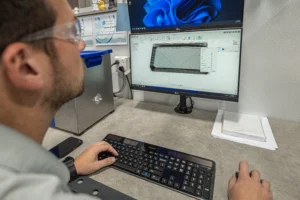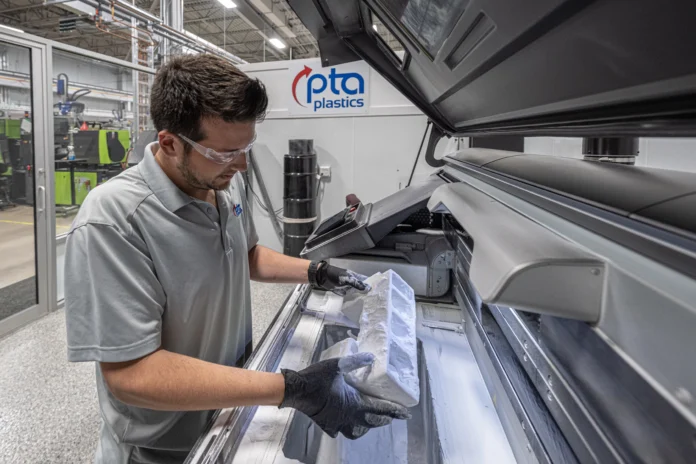By Liz Stevens, writer, Plastics Business
 PTA Plastics is a progressive company that embraces the power of diversity to stay healthy, successful and growing. The company demonstrates its belief in diversity with operations in Oxford, Connecticut and Longmont, Colorado, that offers design for manufacturing, moldmaking, injection molding, value-added services, process validation and specialty molding.
PTA Plastics is a progressive company that embraces the power of diversity to stay healthy, successful and growing. The company demonstrates its belief in diversity with operations in Oxford, Connecticut and Longmont, Colorado, that offers design for manufacturing, moldmaking, injection molding, value-added services, process validation and specialty molding.
The company’s business offerings are spread among a trio of markets – medical device manufacturers, defense industry, and safety and security equipment.
It is no surprise, then, to learn that the company also diversifies the tools and production methods it has available. PTA is heavily into exploring and implementing additive manufacturing (AM) to meet its internal needs and to expand its traditional moldmaking and injection molding production capabilities.
The Impetus
PTA Plastics created an Additive Manufacturing Team as part of the company’s initiative to expand its additive manufacturing knowledge base. To start, the Team installed 3D “starter” printers in both of its locations to be available to all employee-owners for collaborative education.
By exploring a shift from subtractive manufacturing to additive manufacturing, the company discovered options that speed up the turn-around for design changes and repairs, and that shorten the timeframe from design to parts via rapid prototyping. The company now maintains fully-fledged ‟3D labs” in both locations with five types of equipment that offer a variety of AM technologies.
Passing the Test
PTA uses 3D printing to create production and quality fixtures, end of arm tools, automation components and other manufacturing aids. One example is nesting fixtures for the post-molding processing. Instead of machining the complex part surfaces of the fixtures with conventional CNC techniques, PTA experimented with low-cost hobby grade filament printers to see if this could meet its needs. After a smashingly successful experiment, the company began to see the potential of AM, while understanding that no single printer can deliver every possible 3D-manufactured part.
The company now counts on additive manufacturing to deliver a slew of benefits, including reduced lead time from concept to final product, rapid return on investment for the relatively low-cost printers, quicker design changes and reduced costs for material, labor and machine time. 3D printing allows for integrating multiple components into a single design, for specifying design characteristics and infill rates to cut part weight and for incorporating things like printed air lines which eliminates the need for drilling holes, tapping holes for fittings and for the pneumatic fittings themselves.
Additionally, PTA Plastics now is in a position to provide a 3D printing service for low production quantities, design-for-manufacture support and prototyping.
Headwinds
Many established companies face resistance to investigating, testing and incorporating AM technologies. Andrew Gonzalez, injection mold designer at PTA, put it succinctly, ‟Change can be difficult.” Although, PTA Plastics was lucky enough to have a team that was in favor of exploring AM technologies, Gonzalez described some of the minor headwinds that the company faced in its exploration and adoption of 3D printing.
‟It can be a challenge to branch out from the tried-and-true manufacturing methods of a machine/mold shop,” said Gonzalez, ‟and 3D printing is definitely something new to take on within a machining environment.”
One argument raised against AM at PTA was the belief that a 3D print cannot hold the same tolerances that a machined part can hold. ‟While this may be true in certain cases,” Gonzalez said, ‟the remedy is in choosing the correct application for a 3D printed part. For example, PTA uses 3D printed nests to hold parts in place for metrology. As long as the nest can hold the part in a repeatable fashion, this works well. Material drift, which might occur when storing an AM-printed part in a hot environment, must be taken into consideration here.”
Another point that was often brought up at the company was concern about a lack of strength in AM materials and the materials’ ability to handle fluctuations in temperature. ‟This concern,” said Gonzalez, ‟has been put to rest. We found that using high temp materials in our AON printer delivered strong, temperature-resistant parts, and this was true for our PRUSA printers, too, to some degree.”
For AM materials that can meet tolerance and strength issues, PTA can use Delrin filament, (polyoxymethylene, a metal-replacement thermoplastic) or can use its powder bed fusion printer with metal powder materials.
Some PTA Plastics employee-owners were reluctant to dedicate a chunk of company floor space for 3D labs, unsure of the wisdom of changing from subtractive technologies to additive alternatives. ‟There was a little pushback to going all in on valuable floor space for the labs,” Gonzalez explained, ‟so it was important to express our confidence in exploring new technologies and to justify dedicating floor space for new machines and processes. The consensus among employee-owners was that the 3D labs had to offer a return on investment. As it turned out, the investment into the labs has definitely paid off and continues to supply PTA with future technology solutions.”
Back to Basics
Additive manufacturing, contrary to what AM salespeople may say, is not the end all, be all for the future of manufacturing. PTA Plastics tried out 3D in a couple of instances where the technology came up short, necessitating a return to traditional manufacturing.
‟In one case, AM just could not deliver the strength of materials that we needed,” said Gonzalez. ‟We 3D-printed a pickle fork that would be used under high load in a fixture, and it just didn’t have the strength we needed.”
Gonzalez explained that if it broke, a 3D-printed pickle fork would become a safety hazard to operators. ‟In this example, I could see how an AM printing technology such as the Markforged continuous carbon filament might be useful. But, in the end, we made the fork the old school way, out of steel.”
Where Things Stand
During development of the 3D labs, the Additive Team proposed working in phases. ‟Phase one,” said Gonzalez, ‟involved simply printing prototypes. We now are in phase two – utilizing AM prints for fixtures and for finishing needs in the shop. In phase three, we will move into printing for customer-facing needs.”
The company has, however, stuck its toe into the AM production waters for customer-facing needs. ‟While we currently are in phase two, we did print parts for one customer’s end-use,” Gonzalez explained. ‟Our customer in this instance was initially interested in tooling for a product. We tried out AM as an alternative for production. After we delivered the 3D-printed solutions, the customer opted to produce the low-volume product itself via 3D manufacturing and post painting.”
PTA has some new filament AM technologies on its wishlist. ‟There is some interest in purchasing the PRUSA XL or maybe the PRUSA Mark IV,” said Gonzalez. ‟We also are interested in a Markforged unit that can print metal or composites.”
The Equipment Lineup
The company currently has the following lineup of additive manufacturing equipment in each of its 3D labs:
- HP powder bed fusion printer (powder, laser sintered or fused with E beam)
- AON M2+ large format heated chamber FDM printer (filament)
- Prusa MK3S+ printers (filament)
- Formlabs 3L SLA printer (resin, stereolithography)
- DLP printer Saturn Elegoo (resin, masked stereolithography)
- Stratasys Objet30 PolyJet (liquid photopolymer, print head jet nozzles), soon to be retired
Down the Line
PTA is keeping an eye on some cutting-edge AM technology, watching as it matures into viable manufacturing choices. ‟We have had Mantle 3D visit onsite and talked with them about its metal printing system,” Gonzalez said.
‟At this time, we feel that the technology has some maturing to do, including perfecting the printing to avoid hot spots and accommodating overhanging part shapes in prints. The yearly contract fee is rather high. But we’ll be keeping an eye out as this technology progresses in its development.”
PTA Plastics is a company on the go. It is evolving rapidly to meet unfolding challenges and to take advantage of emerging strategies that affect the x, the y and the z – that is, every dimension – of manufacturing.
More information: www.ptaplastics.com




